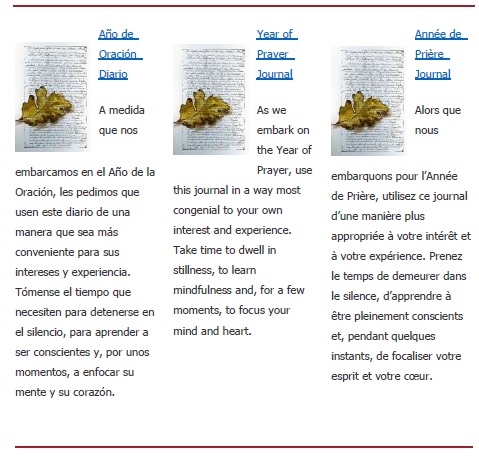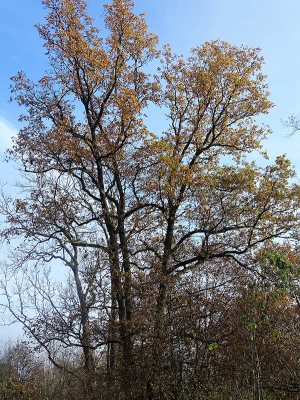Roots and Branches
Roots and Branches
Strong as an oak tree and at the same time flexible in the face of any changes and challenges – this is Philippine Duchesne. It is not only her name that evokes an oak tree; it is even more her character – or is it more than that? Is it her rootedness in God?
The oak tree sends its roots deep into the earth, which makes it strong, resistant to heavy winds and severe thunderstorms. At the same time the oak tree can adjust to different conditions, such as changes of climate.
Especially in her early years, Rose Philippine Duchesne had to overcome many difficulties, which challenged her not to give up but to adapt to different situations: called to religious life soon after her First Communion, she had to overcome her father’s objections to letting her enter the convent. Having entered the Visitation convent of Sainte Marie-d’en-Haut at last, she was forced by the French Revolution, along with all the nuns, to leave the convent. Philippine returned to her family and looked after the poor and sick, until she got into contact with Madeleine Sophie Barat, the founder of the Religious of the Sacred Heart.
What gave her the energy not to give up but to follow her initial vocation? Was it her strong will or rather was it her rootedness in God that gave her the strength to persevere despite all difficulties and failures? This rootedness let her reach out into the whole world, as the oak tree stretches out its branches.
Ilsemarie Weiffen, RSCJ, Province of Central Europe, Germany
Image: Dr. Hubert Zierl, Berchtesgaden
Raíces y Ramas
Fuerte como un roble y al mismo tiempo flexible para enfrentar cualquier cambio y desafío – esta es Filipina Duchesne. No sólo su nombre evoca un roble; es aún más su carácter – ¿o es más que eso? ¿Es su arraigo en Dios?
El roble hace penetrar sus raíces profundamente en la tierra, y esto lo hace fuerte, resistente a fuertes vientos y tormentas violentas. Al mismo tiempo el roble puede adaptarse a diferentes condiciones, como los cambios de clima.
Especialmente en sus primeros años, Rosa Filipina Duchesne tuvo que superar muchas dificultades, lo que la desafió a no darse por vencida, sino a adaptarse a diferentes situaciones: llamada a la vida religiosa poco después de su Primera Comunión, tuvo que superar las objeciones de su padre para dejarla entrar el convento. Al entrar al fin en el convento de la Visitación de Sainte-Marie-d’en-Haut, la Revolución Francesa le obligó, junto con el resto de las monjas, a abandonar el convento. Filipina regresó con su familia y cuidó a los pobres y enfermos hasta que entró en contacto con Magdalena Sofía Barat, la fundadora de las Religiosas del Sagrado Corazón.
¿Qué le dio la energía para no darse por vencida y seguir su vocación inicial? ¿Fue su voluntad fuerte o más bien fue su arraigo en Dios lo que le dio la fuerza para perseverar a pesar de todas las dificultades y fracasos? Este arraigo le permitió alcanzar el mundo entero, como el roble extiende sus ramas.
Ilsemarie Weiffen, RSCJ, Provincia de Centro Europa, Germany
Foto: Dr. Hubert Zierl, Berchtesgaden
Racines et Branches
À la fois forte comme un chêne et flexible face aux changements et aux défis – voilà comment nous pouvons qualifier Philippine Duchesne. Ce n’est pas seulement son nom qui évoque le chêne, c’est également son caractère – ou est-ce plus que cela ? Est-ce son enracinement en Dieu ?
Les racines du chêne sont profondément enracinées dans la terre, ce qui le rend fort, résistant aux bourrasques et aux violents orages. Le chêne est toutefois capable de s’adapter à différentes conditions, comme les changements climatiques.
Dès son plus jeune âge, Rose Philippine Duchesne dut surmonter bien des difficultés, qui la poussèrent à s’adapter aux différentes situations plutôt qu’à abandonner. Appelée à la vie religieuse peu après sa première communion, elle dut surmonter les objections de son père pour qu’il la laisse entrer au couvent. Ayant finalement pu entrer au couvent de la Visitation de Sainte-Marie-d’En-Haut, elle a été forcée de quitter le couvent, avec toutes les autres religieuses, à cause de la Révolution française. Philippine retourna auprès de sa famille et s’occupa des personnes pauvres et malades, jusqu’à ce qu’elle vienne à connaître Madeleine Sophie Barat, fondatrice de la Société du Sacré-Cœur de Jésus.
Qu’est-ce qui lui a donné l’énergie de ne pas abandonner et de poursuivre sa vocation initiale ? Est-ce sa forte volonté ou plutôt son enracinement en Dieu qui lui a donné la force de persévérer en dépit des difficultés et des échecs ? Cet enracinement lui a permis d’entrer en contact avec le monde entier, tout comme le chêne étend ses branches.
Ilsemarie Weiffen, RSCJ, Province de l’Europe Centrale, Germany
Image : Dr. Hubert Zierl, Berchtesgaden
![]()

If you received this message from a friend and would like to receive our messages directly in the future, please sign up on our website.
Has your contact information changed recently? Update your full contact information and your mailing preferences.
Society of the Sacred Heart
4120 Forest Park Avenue, Saint Louis, MO 63108










